RELG 402 - World's Living Religions
Images in the text are linked to larger photos - click on them to see the larger pictures.
Hover the mouse over the images to see their captions.
Hopi Religion
When discussing any religion there are sensitive areas which may not be understood by those who are not members of the religion. This is particularly true of Native American Religions, where some topics may be secret, and are not meant to be open to secular view. To the best of my knowledge, the following information has been made freely available by members of the religion involved, and is published here in the interests of mutual understanding and respect. If the information below is incorrect, or if its publication may be offensive to members of the religion, please contact me
A great deal of information about the Hopi has been published by Frank Waters, in The Book of The Hopi, (1963, ISBN 345-01717-X-125, publisher : Ballantine Books.
Note - there is the possibility that Frank Waters was given incomplete or misleading information by the Hopi elders.
The Hopi sacred stories are orally transmitted, and vary slightly between pueblos and between families. There is also the possibility that when Hopi tell non-Hopis about their religion they omit sensitive material and may change some of the secret details.
| Deities | Creation | Ceremonies |
| Kivas | Sickness | Death |
Click on the thumbnails below for larger photos
![]()
The Hopi live in the Four Corners area of New Mexico, Colorado, Arizona, and Utah, with the main reservation centered around three mesas in northern Arizona.
They regard this area as the heart of "Turtle Island" (the U.S.A.) and of Mother Earth
Their traditions point to the Grand Canyon as the site of the Sipapu, or entrance through which they came to this earth.
They have lived on their lands for at least a thousand years. Their language belongs to the Uto-Aztecan group, and is closely related to the Aztecs of Mexico and to the Northern Paiute.
They live in village settlements, which may indicate a relationship to the earlier Pueblo cultures of New Mexico and Arizona.
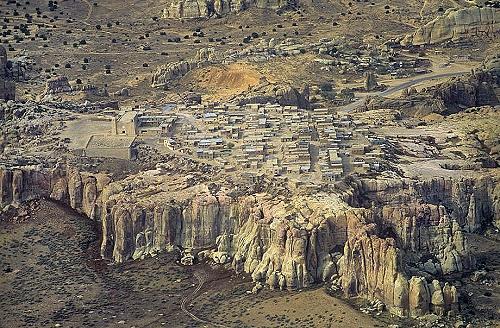 Acoma Pueblo |
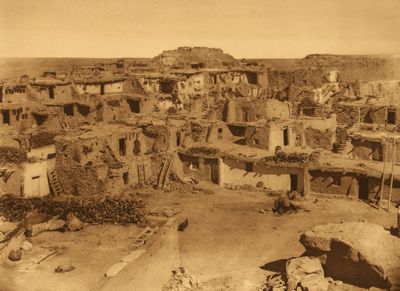 Mishongnovi Pueblo |
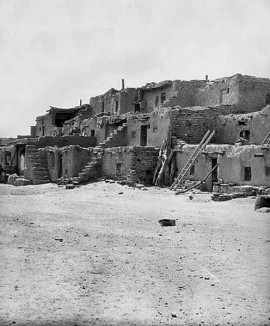 Oraibi Pueblo 1899 |
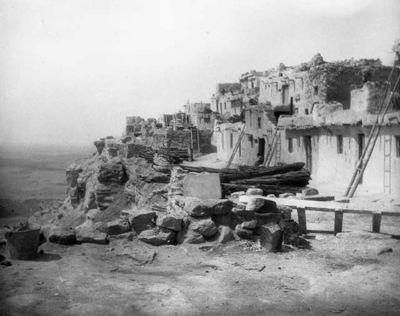 Walpi Pueblo 1918 |
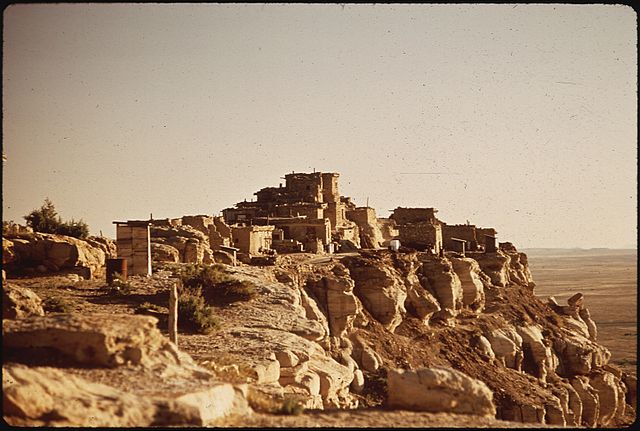 Walpi Pueblo |
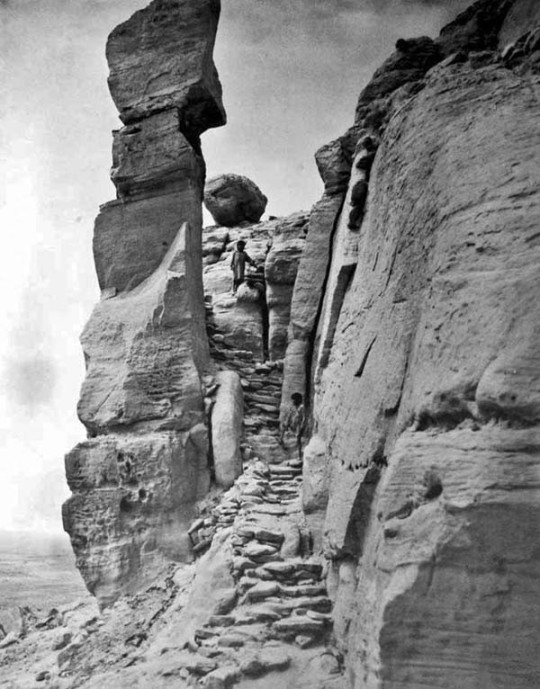 Walpi Pueblo entrance |
The towns are also known as pueblos : the chief one is Oraibi, which was founded ca. 1150. Walpi has been continuously inhabited since 900 A.D. - it is one of the oldest continuously inhabited towns in the U.S. Others are Acoma, Hano, and Tewa
Shungopavi, Mishongovi and Sipaulovi are on Second Mesa.
Kykotsmovi, Old Oraibi, Hotevilla and Bacavi are on Third Mesa.
Sichomovi is a pueblo on First Mesa, founded by Zuni immigrants. Some of the ceremonies there feature kachinas derived from Zuni traditions.
Moenkopi is a Hopi village 45 miles to the west, near the Navajo town of Tuba City - it was originally a summer encampment for farming.
Although the Hopi are surrounded by the Navajo, they are not related to them. The Navajo moved from the north into the region more recently, and took over much of the original Hopi lands.
However, at the time of the Pueblo revolts against Spain (1680-1696), many Navajo fled for safety to the Hopi pueblos. Intermarriage and cultural exchange took place, and the religious traditions and practices of both nations show some blending of ideas.
Hopi religion encompasses the whole of life - all activities have religious meaning.
![]()
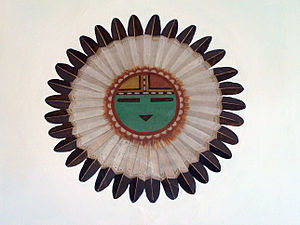 Tawa Mural |
Ka is the Father Creator, and Tawa or Taiowa is the Sun God and the Creator of this earth.
Spider Woman is a messenger between the deities and the people.
The Two Brothers are guardians of this earth. The elder one is Pahana.
Pahana is the Lost White Brother. He entered the Fourth World with the people, and traveled east. It is believed hat he will return from the east, bringing the missing section of a sacred stone tablet, and that he will lead the people into an era of peace in the Fifth World.
Coyote is the trickster.
Kachinas are nature spirits, some of whom are individual personalities, though many of them represent classes of beings such as types of animals. There are about 350 different kachinas. They come from the San Francisco Mountains to the west of the Hopi mesas, but they may also be from the stars or other worlds. They act as intermediaries between human beings and the spirit world, and they bring rain and snow. If an animal is to be killed for meat, the kachina for that sort of animal must be appeased.
Some of the kachinas have been adopted from other peoples such as the Hopi, the Zuni, the pueblos along the Rio Grande, or are associated with other peoples such as the Navajo.
Kachina dolls are wooden figures, traditionally carved from the root of a Cottonwood tree. They represent the kachina dancers. They may be given to Hopi children as toys, and to teach them the symbolism of the figures and their costumes. Hopi artists now make modified dolls for sale to tourists - these do not have spiritual powers.
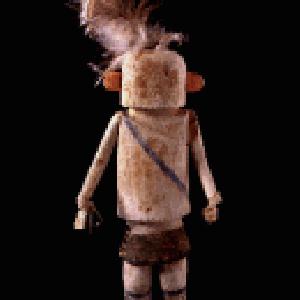 Eototo |
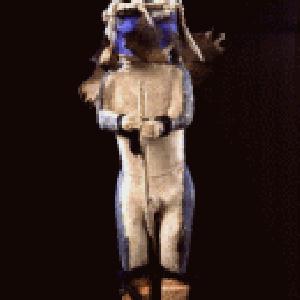 Sotuknang |
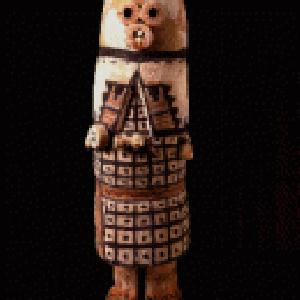 Masau |
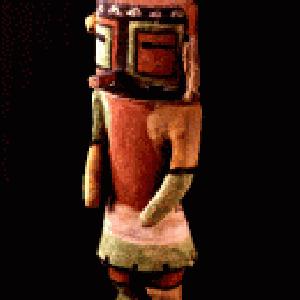 First Cloud Bringing |
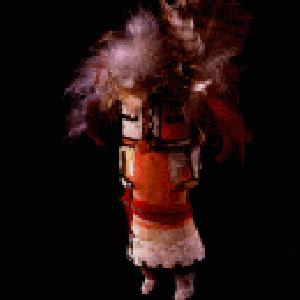 Second Cloud Bringing |
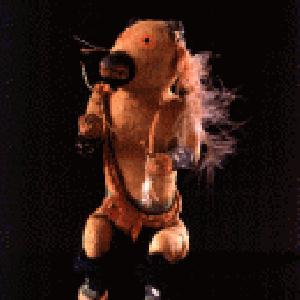 Bear Kachina |
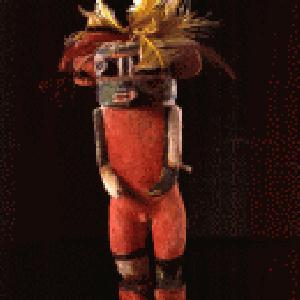 Susukholi kachina |
Eototo is the Father of kachinas.
Sotuknang is the Sky kachina. He is the nephew of Tawa, and in some versions is credited with the creation of Spider Woman.
Maasaw, Skeleton Man, is the Death kachina. He is responsible for the earth's surface and the underworld, and also for fire. Warriors and hunters sought his assistance.
Ma┤lokatsinan, Cloud-bringing Kachinas, dance and pray for rain and a good harvest.
Honkatsina, the Bear Kachina, is a great warrior who also knows all the medicinal roots and herbs and how to use them.
Susukholi is a messenger to the rain gods.
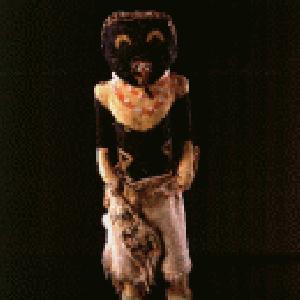 Tsa'kwayna |
 Koonin |
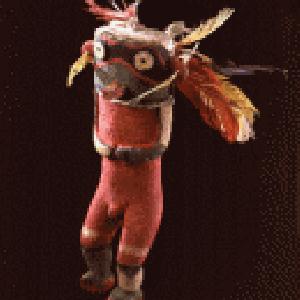 Hootsani |
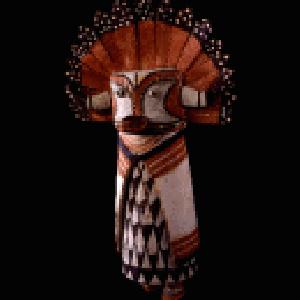 Si'o Sa'lako |
 Pawtiwa |
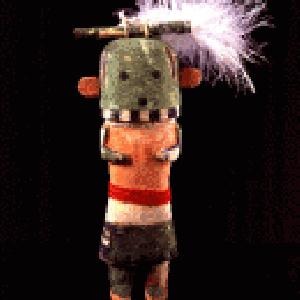 Hatko |
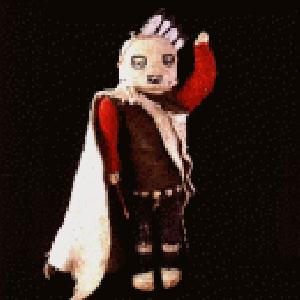 Ye'ii Bicheii kachina |
Tsa┤kwayna is a warrior kachina who brings cold weather and snow to replenish the Hopi springs. He came from the Zuni.
Koonin kachinas sing about the rain. They are related to the Havasupai tribe who live in the Grand Canyon.
Hootsani is a kachina leader who brings gifts for the Hopi. He originated in the pueblos along the Rio Grande.
Si'o Sa'lako are kachinas who came from the Zuni. Si'o is the Hopi name for a Zuni.
Pawtiwa also came from the Zuni, where he is the Sun god and a kachina chief. In Hopi ceremonies he may go to the kivas to announce the coming of the Kachinas to the Fourth World. He helps to bring rain and mist.
Hatko, the Wood-carrying kachina, is another adoption from the Zuni. He carries wood on his head, and dances with Si'o Sa'laka.
Ye'ii Bicheii is the Navajo Grandfather kachina who represents the Navajo nation.
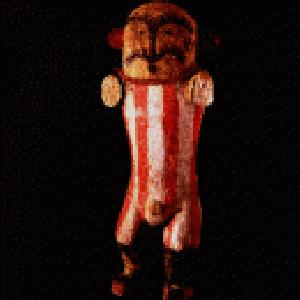 Sikyaq÷ql÷ |
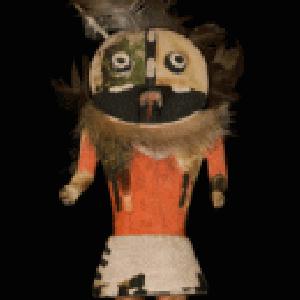 Long Mouth kachina |
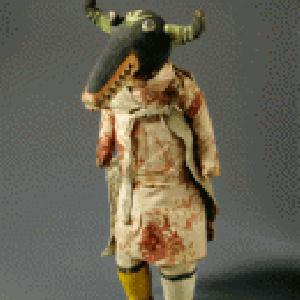 Big Mouth Ogre |
 Mocking kachina |
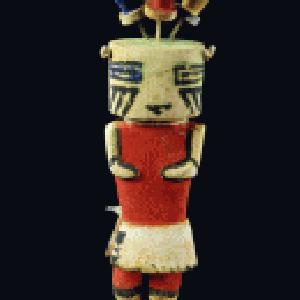 Flute kachina |
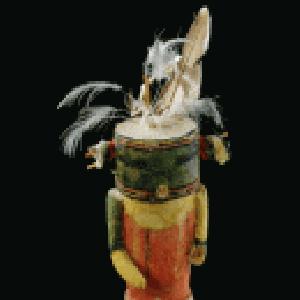 Moth kachina |
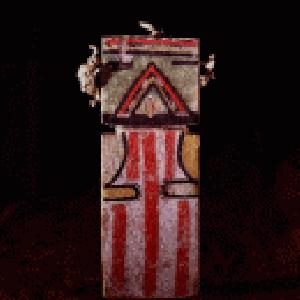 Koo'awkatsina |
Sikyaq÷ql÷ is an artist, storyteller, and farmer. He makes gifts and gives them to the children during the Bean Dance.
Wupamo'katsina, Long Mouth kachina, is a chief kachina. He uses a yucca whip to keep the Mudheads in order, and is in charge of cleaning the streets and kivas before ceremonies, and keeps the processional route clear for the kachinas.
Nata┤aska, Big Mouth Ogre is a chief kachina. The Ogre kachinas appear during Powamuya where they go in pairs threatening to eat people.
Kwikwilyaqa, Mocking kachina, or Striped-nose kachina, is a comic and a mimic who imitates people to amuse the crowd.
Leenangkatsina is the Flute kachina who takes part in the rites that begin the kachina season. His flute music brings rain, a good harvest, and good health. He wears a headdress of flowers of the four sacred colors to represent the beauty of the earth.
Taatangaya is the Moth kachina who represents the moths that pollinate the crops.
Koo┤awkatsina represents rain and clouds. He has not danced since 1914.
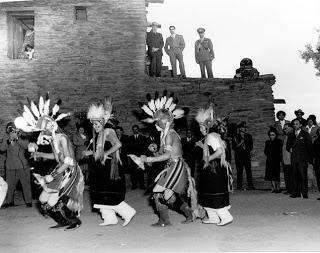 Hopi Dance |
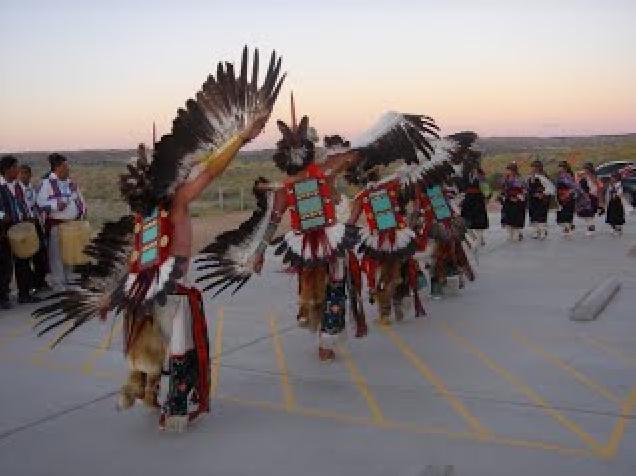 Hopi Dancers |
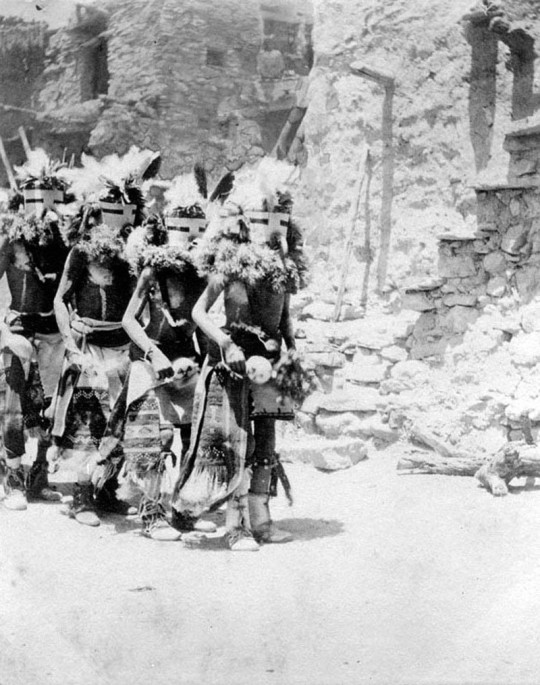 Hopi Dancers, 1891 |
Kachina dancers are men who wear masks and costumes representing the kachinas, and take part in ceremonial dances. While wearing the masks the Kachina dancers lose their human identities and are believed to have supernatural powers related to the kachina they become. Each kachina has a unique mask whose shape, color and adornments have religious significance
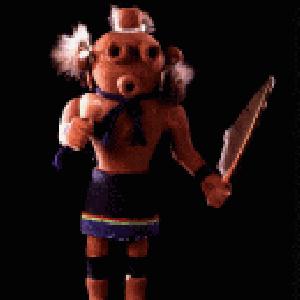 Mudheads, or Koyemsi, serve as healers, warriors, magicians, and messengers between the kachinas and human beings. Dancers representing the Mudheads cover their bodies with clay, to symbolize the earth from which human beings were formed. They are descended from a brother and sister pair. They are not kachinas, but they live near the kachinas and accompany them, often carrying a rattle or a drum, and provide entertainment for the audience during breaks in the dancing. Mudheads were originally Zuni.
Mudheads, or Koyemsi, serve as healers, warriors, magicians, and messengers between the kachinas and human beings. Dancers representing the Mudheads cover their bodies with clay, to symbolize the earth from which human beings were formed. They are descended from a brother and sister pair. They are not kachinas, but they live near the kachinas and accompany them, often carrying a rattle or a drum, and provide entertainment for the audience during breaks in the dancing. Mudheads were originally Zuni.
 Hano Clown |
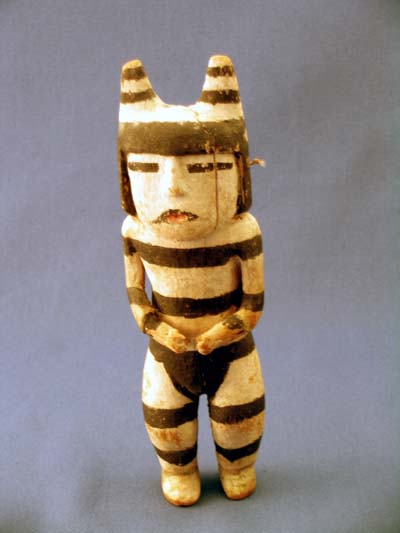 Hopi Koshare |
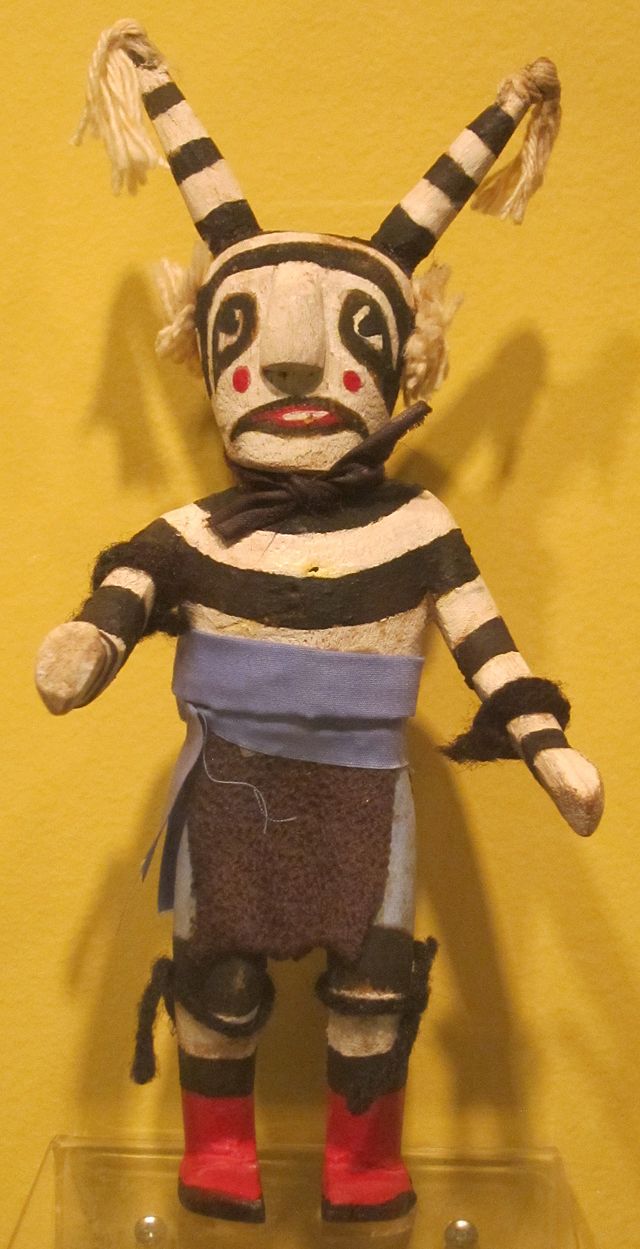 Hopi Koshare |
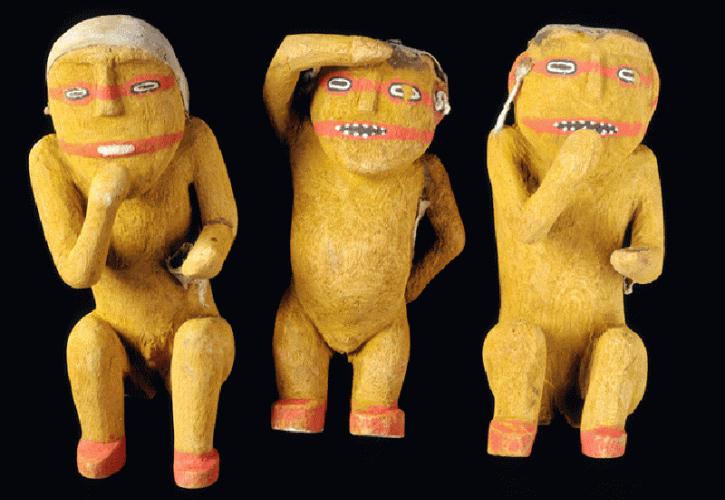 Hopi Clown kachina dolls |
Hano Clowns or Koshare paint their bodies with black-and-white stripes and wear distinctive headdresses. They accompany kachina dancers and act in a boisterous and impolite manner.
![]()
In the beginning there were two Beings : Tawa, the Sun God, and Kokyanwuhti, Spider Woman. The cosmos was divided into the Above, which belonged to Tawa, and the Below, which belonged to Spider Woman. There were no other living beings.
Then Tawa divided himself and made Muiyinwah, God of Life (some sources name him Sotuknang).
Spider Woman divided herself and made Huzruiwuhti, (Woman of the Hard Substances - turquoise, silver, coral, shell, etc.).
Tawa and Huzruiwuhti had many children.
Then Tawa and Spider Woman had the Great Thought of creating the earth between the Above and the Below. Tawa "thought" each step, and Spider Woman molded the thoughts and formed them with clay. Tawa thought of earth, and plants and animals, and of people, and Spider Woman molded them of clay. Spider Woman used four colors of clay, to make four colors of people, yellow, red, white, and black. Then Tawa and Spider Woman breathed into the forms, and they became living beings. Sotuknang gave them the gift of speech - each color had a different language, and Sotuknang told them that they must respect one another, and always respect and honor the Creator.
Spider Woman led the people through the Three Great Caverns of the Underworld until they came to the Sipapu - an opening to the Earth above.
The ancient creatures and people did not initially live on top of the earth - they lived under it, and everything was in darkness. There were Four Worlds - the one on top of the earth, where we now live, and three Cave Worlds, one above the other. The people lived in the lowest cavern, but it was too small for them all, and they crowded upon one another. They began to please themselves rather than respecting the Creator, and the animals became afraid of them and withdrew form them. The people of different colors began to draw away from one another.
Then the Two Brothers came down to the lowest cavern and spoke to the people. The Two Brothers planted a corn plant which grew up to the top of the cavern, so that the people could climb up it and through the hole in the roof into the cavern above. Some say that the first world was destroyed by fire.
When some of the people had climbed into the second cavern, it too was dark, and they were afraid that there would not be room enough for everyone, so they pulled the ladder (the cane plant) up, and did not allow the remaining people to climb up. However, those who were left in the lower cave eventually did climb out and became the peoples to the west.
The second cavern also soon became overcrowded, so the people used the cane ladder to climb up to the opening in the roof and climb into the third cavern. The first people up the ladder also pulled it up and would not let everyone up the ladder. Some say that the second world was destroyed by ice.
The third cavern was also dark, until the Two Brothers found fire and people were able to make torches and see where they were going. Because they had light, the people were able to build houses and kivas, and to travel from place to place. However, a bad time of discord came, when the women started to behave like men, and danced in the kivas (the religious places reserved for men), while the men had to stay at home and look after the babies.
Once again, the people decided to climb out of the dark cave (some say that the third world was destroyed by a flood), and this time they climbed into the Fourth World - but it was also dark because the sky was like a roof. People still had to go about with torches.
While they were stumbling around looking for food, they found a small field of corn, beans, squash, and watermelons, with a great fire burning and a tall man wearing a turquoise necklace and ear pendants. The man told them his name was Skeleton (or Corpse) and gave them food from his field. Although the field was small, there was enough food for everyone. Then Skeleton showed the people how to prepare their own fields and grow corn. They now had enough food, but it was still dark unless they made fires. Spider Woman spun pure white cotton - but it did not give enough light.
So the people decided to make a light. They cut a great circle of buffalo hide, stretched it on a wooden frame, and painted it white. They told one of the young men to stand on the circle, then they sang a magic song and swung the disk high into the sky. It became the moon - but although it gave some light, it did not give any heat.
So the people talked to Skeleton again, and decided to try something stronger. They took some cloth that they had woven, and painted a circle with copper-colored paint to make a face. Then they made a circle of corn husks around the face, with a string of red hair wound amongst the corn. They put a ring of corn husks at the back of the disk, and a circle of eagle feathers through the ring. Then the Chief tied some small red feathers to the tip of each eagle feather, and a piece of abalone shell on the forehead of the face. So the sun disk was made.
Another young man was chosen to stand on the disk, and the people swung it into the sky towards the east. The sun arose, and there was light and warmth.
The people decided to travel to find places to live (some say that they were told to travel to the ends of the earth and then come back). The White people followed a trail to the south. The Hopi chose a trail to the north. The Pueblo people followed a trail between the first two.
Eventually the Hopi came to the mesas where they now live, and there they settled, built houses, and raised crops.
Another version : Five other beings came from the Cave Worlds to the Upper World with the people - they were Spider, Coyote, Swallow, Vulture, and Locust. Coyote brought a heavy jar that he had stolen. It was so heavy that he was thinking of throwing it away, but when there was light from the moon he decided to look inside the jar first. As he opened the jar, many shining sparks flew up into the sky and became stars. As they flew out, Coyote's face was singed, which is why Coyote now has a black face.
The world as it was then was very small and surrounded by water, so the people asked Vulture to help, and he spread his wings and fanned the waters until they flowed away and mountains appeared.
The Two Brothers cut channels for the water through the mountains, and as the water flowed through the channels it dug them deeper and deeper until the great canyons were formed.
The people could see the tracks of Death (Skeleton) who had gone before them, and they followed his tracks - He was waiting for us on this world and he goes before us on this world, and he is our father and master.
The people followed the tracks of Skeleton, and caught up with him. Among the people were two little girls. One was the daughter of a great priest, and she was very beautiful. The other was not beautiful, and she was jealous of the beautiful girl, so she and Skeleton caused the death of the beautiful girl. This was the first death. The girl's heart stopped beating, and her body grew cold.
The priest was angry at the death of his daughter. He took some sacred cornmeal and some pollen, made it into a ball, and threw it into the air. When it fell, it struck the head of the jealous girl, so he knew that she was guilty and called a Council of the people. The Council decided that she should die, but she told them to go back to the sipapu and look down it.
When they did so, they saw the priest's beautiful daughter walking among flowers in a land of everlasting summer. The beautiful girl was so happy among the flowers that she took no notice of the people, and did not want to return to their world. The jealous girl explained that when we die, we will return to the world from which we came, and we will be happy, and should not fear death.
The people decided not to kill the jealous girl. She grew up, and her children became witches and wizards. They still live among us, and have dreadful magical powers.
As the people continued their journey, they discovered Locust in their midst, and told him that he must go back to where he came from. He replied that he had come with them so that he might be useful, but they still told him to go back. Locust refused, and the people became angry and killed him with arrows through his heart. His blood ran out and he died. But after a long time Locust came back to life, looking as before, except that now he was black. The people decided that Locust would indeed be useful, as he had the power of renewing life. That is why now-a-days the Locust is first white, then he dies, then he comes back to life as a black Locust. So the Hopi use Locust for medicine to heal wounds.
The people had forgotten to bring seeds with them from the lower Cave Worlds, so they had nothing to plant, and they became hungry. Then the Dew Spirit sent Swallow back to bring seed corn and other seeds. Dew Spirit planted the seeds and chanted prayers over them. The corn sprang up and grew to full size and produced ripe corn in just one day. The people continued on their journey, and Dew Spirit gave the seed to the Corn Clan so that they could raise corn.
However, the witches and wizards, the children of the jealous girl, made the time for raising corn grow longer and longer, until now we have to wait a whole summer for the corn to ripen. The witches and wizards also made other trouble - some people had emerged from the Cave Worlds before the Hopi, and the witches and wizards stirred them up to make war on the Hopi. The Hopi had to build houses on high mesas with only one trail up the mesa, or in caves with only one path to the cave, or up on the sides of deep canyons.
Another version recounts how the Hopi clans wandered across the land, from one end to another. The clans multiplied and split into more clans - there were times of peace, when clans lived together in harmony, then there were times of discord and argument, when clans split and went separate ways. Eventually the clans completed their migrations, and returned to their center - the lands they now occupy. The Bear Clan was the first to return, and they founded the pueblo of Oraibi.
![]()
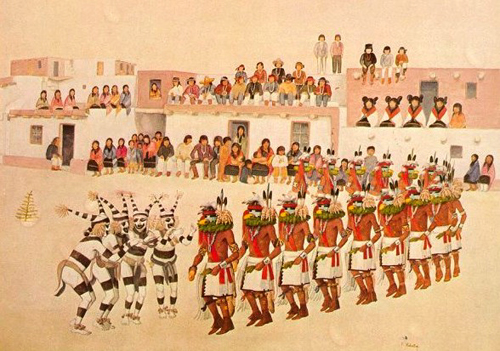 Hopi Dance, 1921 |
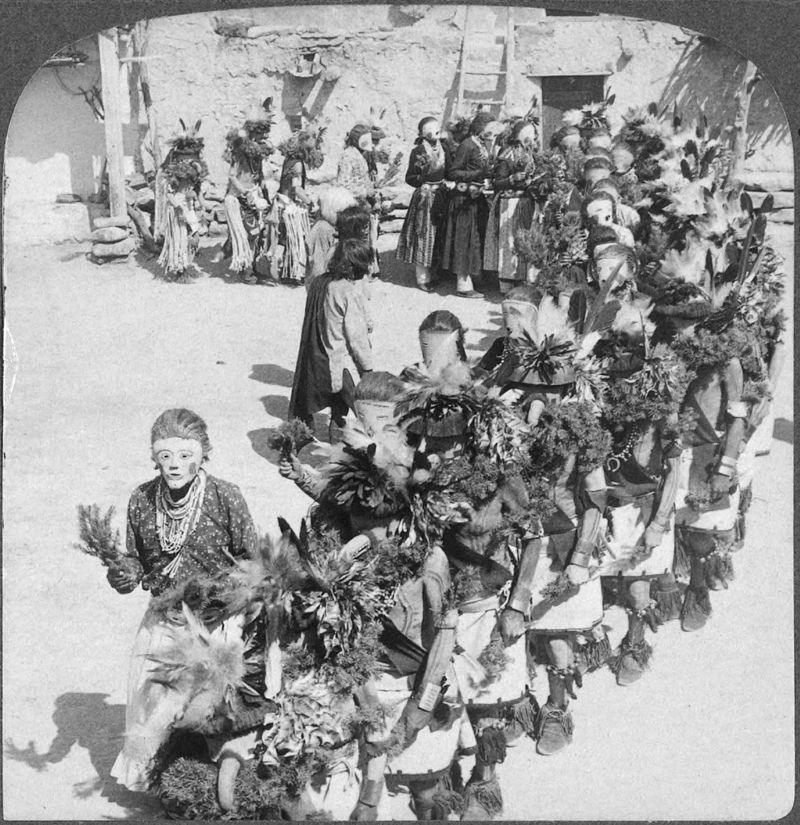 Hopi Dancers, 1900 |
 Hopi Harvest Dance |
 Hopi Dance, 1910 |
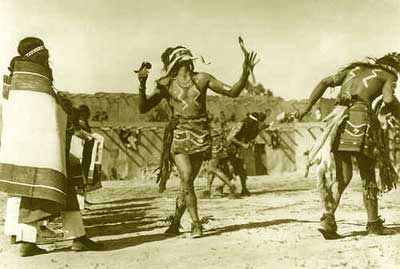 Hopi Snake Dance |
Each Hopi clan performs a unique ceremony, and the ceremonies maintain the balance of the natural forces of sunlight, rain and winds, and reaffirm the Hopi respect for all life and their trust in the Great Spirit.
Hopi men join one of the of the four fraternities, and Hopi women may join one of the three sororities which perform the Emergence ceremony; there are also other societies which perform other ceremonies.
The leaders of the clans act as chief priests and priestesses. There is no full-time or professional priesthood - those taking part in ceremonies return to everyday life when the ceremony is over.
Unlike the Navajo, the Hopi have no medicine men or healers - communication with the spirit world is through the priests, and is linked to the clan rather than to an individual.
The main parts of the ceremonies are secret, and are held in the kivas. They end with Dances which are performed in public in the plaza of the pueblo.
The ceremonial year starts with Wuwtsim, the Emergence Ceremony, in November.
Slyalkachina, a chief kachina, begins the season by walking like a tired old man into the village, singing sacred songs as he goes. He opens the main kiva, allowing the kachinas to come out. This is a re-enactment of the emergence of the Hopi into the Fourth World. The ceremony takes eight days of purification and preparations, then eight days of kiva rituals
Soyal occurs at the time of the Winter Solstice, when plans are made for the ceremonial activities of the coming year; Soyal is conducted by the Chief of the village, with officers who hold the leading ceremonial roles in the village. Elders recount the stories of the Hopi, to the children and to the adults. These are intended to be guides for a good Hopi life.
Soyal lasts for nine days, during which prayer objects are made, and concludes with a rabbit hunt and a feast.
It helps to turn the sun towards his summer home, and gives strength for the growing season which is approaching.
Kachina dances begin after Soyal, and continue through the season until July.
Powamuya (Bean Dance) takes place in January-February, and is a planting festival. Bean seeds are sprouted and raised secretly in the kivas in preparation for the coming year. During the ceremony the Kachina dancers distribute the bean plants to the young children of the pueblo, along with a present of a bow to boys, and a kachina doll to girls. It is a time when children between the ages of six and ten are initiated into the Kachina societies. The children are then allowed to take part in the ceremonies. Powamuya is a great kachina festival, with many dances.
Osomuya (Night Dance) take place in March - the kachinas dance to bring the rain.
Kwiyamuya is in April, and is the time when fruit trees are in bud, and early crops are planted. Kachinas come to the village plaza and challenge boys and men to footraces - this blesses them with strong lives and causes the water to rush down the arroyos. Mudhead kachinas visit the villages, and cause merriment and entertainment.
Hakitonmya (Plaza Dance) is in May, and is the time for planting beans, melons, and gourds. Men go to capture young eagles and hawks for their Clans. They leave a gift of turquoise or shell in the nest as a gift to the mother bird. The young birds are treated like Hopi children - they are blessed, washed, and given a Hopi name. They are kept in the village until the time the kachinas leave in July.
Wuko'uyis is the June planting season. The sacred corn has to be blessed so that it will grow to maturity.
It is also the time for the clowns to visit - they are an important part of ceremonies, acting in ways to illustrate how a Hopi should not behave - disrespectful, noisy, dishonest, lazy. They show up any unacceptable behavior.
Niman or Home Dance is held in July and celebrates the return of the kachinas to their homes in the mountain peaks and in the Underworld. The young eagles are given the same gifts that good Hopi boys and girls get - bow and arrows and kachina dolls. Then they are killed by smothering them in cornmeal, and most of their feathers are plucked for use in future ceremonies. The birds and their gifts are given a ritual burial so that they may return with the kachinas to the spirit land.
The kachinas take a message to their homes, asking them to be happy, but not to forget the people, and to send rain and a good harvest.
Snake Dance (or Snake-Antelope Dance) and Flute Dance are held every two years, in alternate Augusts. The Snake Dance commemorates war and destruction. the Flute Dance celebrates the continuity of life after death.
The Snake ceremony takes sixteen days, and the Snake Dance is performed on the last day.
The Snake Dance is performed with live rattle-snakes, which the Snake priests hunt and collect prior to the dance. It is performed to ensure rains and spring water for crops and drinking. Snakes are seen as messengers to the Underworld, and it is hoped that they will deliver the request for water. During the ceremony the dancers take live rattle-snakes into their mouths. After the ceremony the snakes are released into the desert to carry the messages for water to the Underworld.
Mamrawt is held in September, and is the principal women's ceremony. It is performed by the women who are initiated into the Mamrawt society. The focus is upon prayer and meditation.
Lakon is held in October, by women who are members of the Lakon society.
O'waqolt or the Basket Dance is the last of the women's ceremonies. Men and women both take part in the Basket Dance.
In addition to the regular annual ceremonies, there are many other ceremonies that are held from time to time - they vary from one village to another.
The Hopi make sand paintings as part of some of their ceremonies. It is probable that the Navajo adopted the use of sand paintings from the Hopi.
An important part of most Hopi ceremonies and shrines is a pahos, or prayer stick. It is made from a willow stick, painted, and adorned with feathers - eagle feathers take messages to the Creator. A pahos is made according to specific rituals, with prayer and smoke.
Some ceremonies involve the use of tobacco. The tobacco which grows wild in the southwest is different to the commercial cultivated tobacco. It is much stronger, and contains hallucinogenic alkaloids - it is used only for ceremonial purposes, not for recreational smoking. The leaves are dried, and smoked in a cane tube or in a short clay pipe. A man from the Tobacco clan fills the pipe, and a man from the Fire clan lights it. Those participating must be united in their thoughts and focussed on harmony. If one person has bad feelings such as anger or greed the prayer will be ruined.
Besides restoring balance to the world, the ceremonies have specific purposes, and also are intended to bring rain. The kachinas especially are thought of as rain-givers, and kachina dances are public events intended to be enjoyed by all.
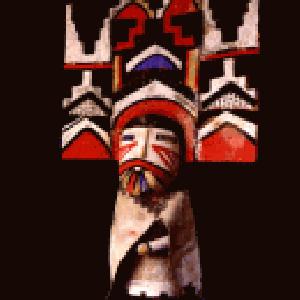
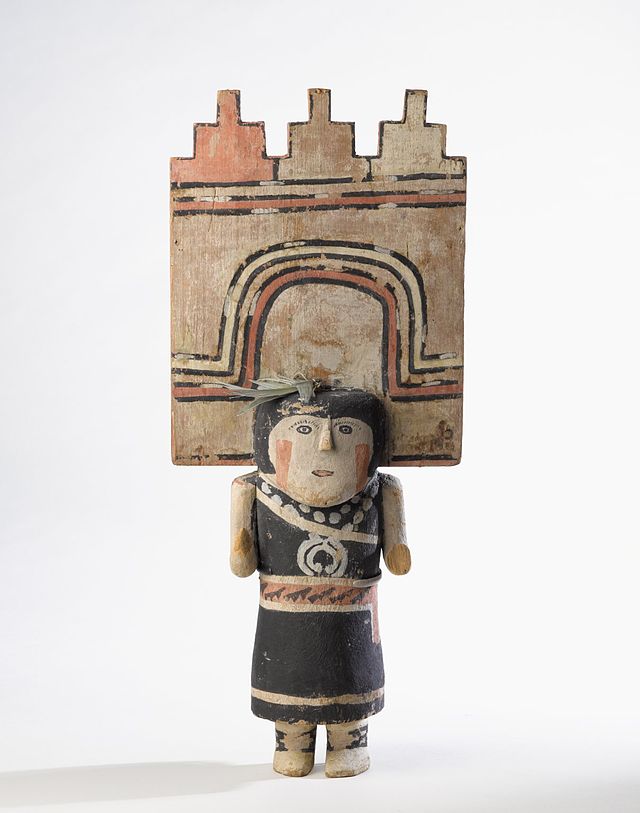 Butterfly Maiden, Palik Mana, is a female figure who is portrayed in the ceremonies by a man or young woman. She wears a headdress with a rain and cloud design, and dances with a male partner. She may grind corn as part of the ceremony.
Butterfly Maiden, Palik Mana, is a female figure who is portrayed in the ceremonies by a man or young woman. She wears a headdress with a rain and cloud design, and dances with a male partner. She may grind corn as part of the ceremony.
The end of all Hopi ceremonies will come when the Blue Star (Saquasohuh) kachina dancer removes his mask during a dance in the plaza before uninitiated children (the general public). For a while there will be no more ceremonies and no more faith. It will be a time of disunity and corruption which will spread throughout the world. Then the Hopi land will be restored, with its faith and ceremonies, and a new cycle of Hopi life will emerge into the Fifth World.
![]()
 reconstructed Kiva, Mesa Verde |
 Snake Kiva, Walpi, 1899 |
A kiva is a subterranean building used for religious purposes and as a clubhouse for a men's society. Women do not enter a kiva except to clean it, bring food, or to view a ceremony.
A kiva is entered by a ladder through a hole in the roof. The kiva is usually circular, with a flat roof with a central opening, which represents the place of emergence into this world. Its inside walls are coated in plaster, covered with religions murals.
Kivas represent the three other worlds that all beings traveled through before they emerged into the Fourth World.
A small hole in the floor of the kiva represents the sipapu which comes up from the First World - the World of Fire. The sipapu is usually covered with a stone except during the ceremony for the initiation of young men. During other ceremonies, the stone is stamped upon so that the dead may be aware of the ceremony. A small fire burns near the sipapu - it is the only source of light in the kiva.
Secret ceremonies are held in the kivas before the ceremonial dances. The dances are performed in the public plaza of the pueblo.
The floor of the kiva represents the Second World, the World of Air, the breath of life.
A raised seating area represents the Third World, the World of Water, the blood of life.
A ladder reaches up to a hole in the roof, leading to the Fourth World, where we now live.
![]()
Sickness can be caused by negative or sad thoughts, anger, jealousy, and things which disturb the harmony of the body. Sickness may also be caused by witchcraft, or by exposure to dangerous forces such as lightning.
Healing is done by shamans, or by members of ceremonial societies that specialize in cures for particular diseases. Native home remedies may be employed.
![]()
A peaceful death in old age is desired. Other forms of death may be caused by witchcraft or by disease. As soon as possible after death the body is buried outside the village by a son or other close relative. The body is buried facing east, the direction from which Pahana will return.
The spirit of the dead person returns to the Underworld through the sipapu in the Grand Canyon; hence this is a place of special reverence and awe, to be avoided rather than visited casually.
Hopis believe that the spirit of the dead person may try to take others with it, so there are various rites necessary for protection against this, However, once the dead have reached the Underworld they are friendly towards the living. They return with the kachinas to bring rain to the world.
Copyright © 1999 Shirley J. Rollinson, all Rights Reserved